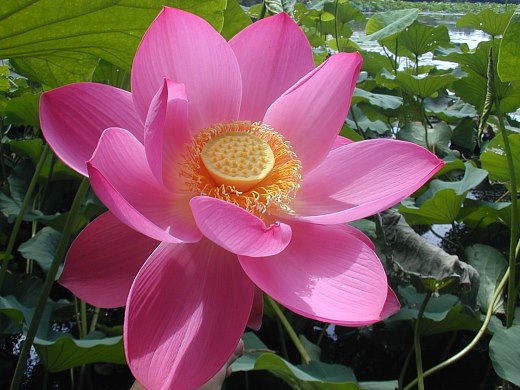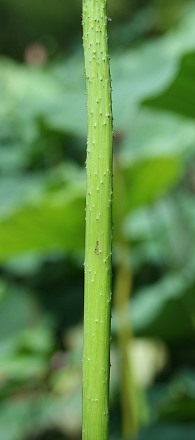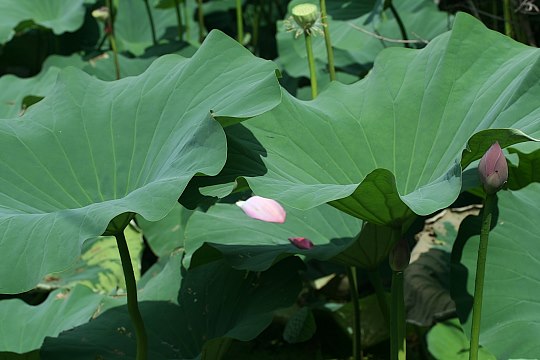Description: This perennial plant is an emergent aquatic that produces individual leaves and flowers directly from the root system. The blades of the leaves either float on the surface of the water, or they are held up to 5' above the water surface by their petioles (often the latter). These circular peltate blades are 1½-3' across, medium green or blue-green, and hairless. Their margins are smooth, often undulating up and down. Each leaf blade above the water surface is depressed toward the middle where it is joined by the petiole. Many veins radiate from its center in all directions; these veins become forked as they approach the outer margin of the blade. The stout petioles are light green, terete, hairless, and either smooth or somewhat prickly. The interior of each petiole contains hollow chambers that keep the petiole erect and convey oxygen to the root system.

Individual
flowers are held up to 6' above the water surface by their peduncles
(flowering stalks). Each flower is 4-10" across, consisting of about 15
pink tepals, a golden yellow receptacle, and a dense ring of golden
yellow stamens (although the anthers are often white). The receptacle,
which is located in the center of the flower, is shaped like an
upside-down cone. Along its flat upper surface, there are 15-35 short
styles that look like small bumps. The blooming period occurs during
the summer and can last 2 months. The short-lived flowers open up
during the morning and begin to lose their petals by the afternoon;
they have a pleasant fragrance. Each flower is replaced by a seedpod
spanning 3-5" across and ¾-1" deep; this seed pod becomes dark brown at
maturity. Along the upper surface of the seedpod, individual seeds are
exposed in small chambers. Eventually, each
seedpod bends downward to
release its seeds into the water. The root system has thick rhizomes
with fibrous roots. Sacred Lotus spreads by its rhizomes or seeds; it
often forms sizable colonies.
chambers. Eventually, each
seedpod bends downward to
release its seeds into the water. The root system has thick rhizomes
with fibrous roots. Sacred Lotus spreads by its rhizomes or seeds; it
often forms sizable colonies.
Cultivation:
The preference is full sun, water up to 6' deep, mucky submerged soil,
and a sheltered location with little exposure to wind and waves. This
introduced plant can spread aggressively and completely take over a
shallow pond. Some cultivars of the Sacred Lotus are hardy to Zone 5.
The seeds of Sacred Lotus can remain viable for several centuries.
Range & Habitat:
Thus far, there are no records of the non-native Sacred Lotus escaping
from
cultivation and naturalizing into new areas within the state of
Illinois (see Distribution
Map). However, many states in southeastern United States have
records of such escaped plants, and there is some evidence that Sacred
Lotus has escaped in Ohio, West Virginia, New Jersey, and New York.
There is really no reason why this plant can't escape from cultivation
in Illinois. Habitats include small ponds and shallow areas of lakes
and rivers. Sacred Lotus is native to southern and eastern areas of
Asia.
Faunal Associations:
Information about floral-faunal relationships is unavailable for Sacred
Lotus in North America. However some floral-faunal relationships of the
native Nelumbo lutea (American Lotus) are known,
which may generalize to the Sacred Lotus. For the American Lotus,
typical flower visitors are various bees, including the small
oligolectic bees Hylaeus nelumbonis, Lasioglossum
nelumbonis, and Lasioglossum nymphaearum.
These floral visitors collect pollen from the flowers. Caterpillars of
two moths, Bellura obliqua (Cattail Borer Moth) and
Ostrinia penitalis (Lotus Borer Moth), bore
through the pedicels of the leaves and peduncles of the flowers. Among
waterfowl, the Canada Goose, Mallard, and Northern Shoveler eat the
seeds of American Lotus.
Photographic Location:
A pond at Parkland College in Champaign, Illinois, where a colony of
Sacred Lotus persisted for several years, although it was later
destroyed.

Comments: This exotic wetland plant has huge leaves and flowers. Sacred Lotus is very showy and attractive, but potentially invasive of some wetland habitats should it escape. The native species, Nelumbo lutea (American Lotus), is also very showy and attractive, and it can spread aggressively in some wetland habitats as well. Because American Lotus has pale yellow flowers, it is easy to distinguish from Sacred Lotus. Otherwise, these two species are very similar in appearance. Cultivars that are hybrids of these two species tend to have whitish pink flowers. In east Asia, the rhizomes and seeds of Sacred Lotus are used as a source of food. The seeds can be cooked and eaten like popcorn.